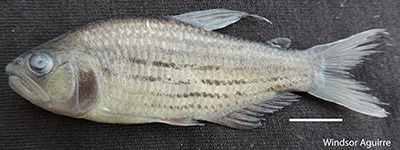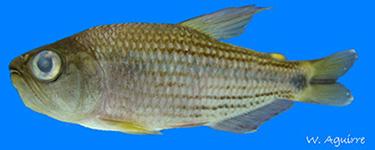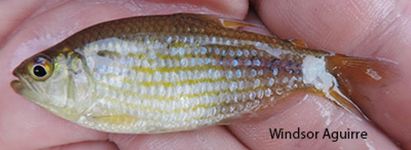| SOURCE FOR OCCURRENCE IN ECUADOR: Bohlke (1958), Glodek (1978), Barriga (2012), Jimenez et al. (2015), etc. |
| ORIGINAL DESCRIPTION: Kner, R. 1863. Eine Uebersicht der ichthyologischen Ausbeute des Herrn Professors Dr. Mor. Wagner in Central-Amerika. Sitzungsberichte der Koningl. Bayerischen Akademie der Wissenschaften, München v. 2: 220-230. |
| TYPE SPECIMENS: |
| TAXONOMIC STATUS: Valid (Eschmeyer and Fricke, 2012). |
| RANGE ECUADOR: Glodek (1978) reports this species from the Esmeraldas and Santiago Rivers in northwestern Ecuador. Barriga (1991) also listed this species as occurring in northwestern Ecuador. However, Aguirre and collaborators collected a specimen in the upper Guayas River drainage in July 2008 (00 35' 05.3" S, 79 17' 27.2" W). This is the specimen that appears above on the right. |
| RANGE OUTSIDE OF ECUADOR: None (Glodek, 1978). |
| COLLECTIONS IN ECUADOR: |
| MAXIMUM SIZE: 7.5 cm total length (Fishbase, 2012). |
| DISTINGUISHING FEATURES: Gery (1977) indicated that Pseudochalceus is probably an old genus that may date back to the end of the Mesozoic Era (over 65 million years ago). Pseudochalceus can be distinguished from other small tetras occurring in southwestern Ecuador by its body form, large mouth, and coloration. Interestingly, the genus is restricted to Ecuador, Colombia and southeastern Brazil (Gery, 1977; Glodek, 1978). Pseudochalceus lineatus can be distinguished from the other species in the genus occurring in western Ecuador by the presence of a series of dark longitudinal stripes running along the length of its body. Other tetras in the region lack longitudinal stripes. Meristics: 11 dorsal fin rays, 25-26 anal fin rays, 36 lateral line scales (Glodek, 1978). Bohlke (1958) lists lateral line scales as 34-36. |
| ECOLOGY: May have a wide altitudinal range. Most specimens have been reported from 1000-6000 ft in elevation. However, Bohlke (1958) listed specimens collected at much lower elevations in the Rio Santiago drainage. |
| ECONOMIC IMPORTANCE: Not of economic importance because of its small size. |
| CONSERVATION STATUS: NA. Reported from northerwestern Ecuador so may be common in that region. May be rare in the Guayas River system or restricted to higher elevations in that system. |
| LINK TO FISHBASE PAGE: Click here for link |
| SPECIES PROFILE CREATED BY: Windsor Aguirre |
| SPECIES PROFILE CONTRIBUTORS: NA |


